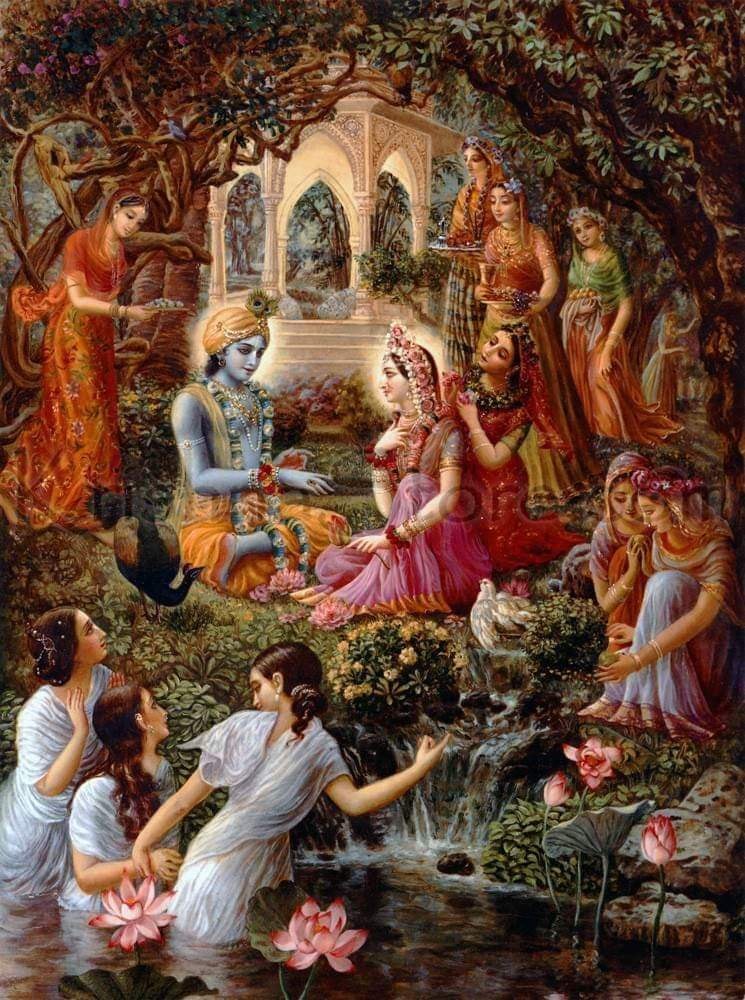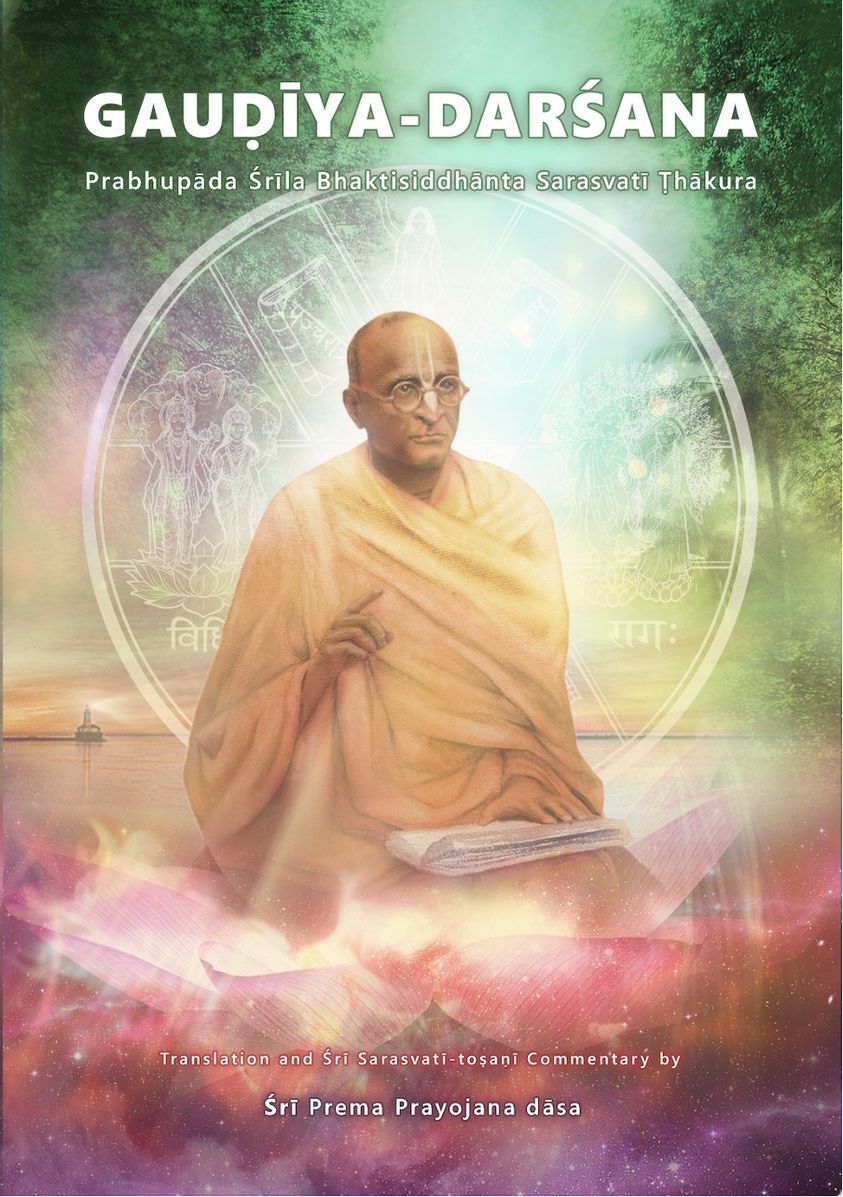This year, 30 December 2018 is the disappearance day of Srila Gurudeva,
Tridandi Swami Sri Srimad Bhaktivedanta Narayana Gosvami Maharaja.
Please find one of His amazing classes below
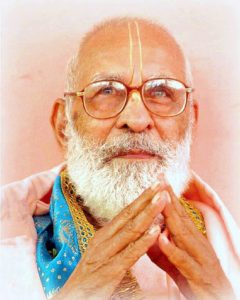
Srila Gurudeva,
Tridandi Swami Sri Srimad Bhaktivedanta Narayana Gosvami Maharaja.
THE HEART OF AN EXCESSIVELY ATTACHED PERSON IS LIKE A HOT DESERT
The Western countries had no background or even a smell of Krishna consciousness. I know that is very hard to sow the seed of devotion in the Western countries. But, Svamiji ( Srila Bhaktivedanta Swami Prabhupada ) mercifully gave this seed of bhakti. If this seed is properly watered, tended to, and nourished, then leaves will gradually unfurl and this seed will take the form of a very, big tree. It may also take the form of a beautiful creeper. This tree or creeper will cross the heavenly realms and enter the spiritual sky. It will also cross the abodes of Vaikunta, Ayodhya, Dvaraka, Mathura and will finally find shelter at the lotus feet of Krishna in Vrindavana. So, it is very difficult to sow this seed of devotion in anyone, especially in someone who has a dry heart.
Srila Gurudeva: First of all, I want to glorify my Gurudeva, Nitya Lila Pravista Om Vishnupada Astotara satta Sri Srimad Bhakti Prajnana Kesava Gosvami Maharaja, who is the Sannyasa guru of Svamiji ( Srila Bhaktivedanta Swami Prabhupada ) I also offer my hearty honour to the lotus feet of Svamiji. He was a very powerful Acharya. He came to the Western countries where there was no previous background or platform made for the cultivation of Krishna consciousness. All the people there were absorbed in eating, drinking, and making merry. But, despite his old age, Svamiji came to the Western countries having no money with him. He came by a ship. All of you know how Svamiji came to the West. I have explained Svamiji’s visit to America in a detailed way in Holland. So, I am not going to repeat the explanation.
[Srila Gurudeva speaks to a devotee from the Bhaktivedanta Manor.]
What will be a suitable time to go?
Devotee: We would like to go at 7’o clock.
Srila Gurudeva: Will it be convenient for you all to come at this time?
Devotee: Maharaja, I spoke with Brajanatha Prabhu, and he will speak to you a little later.
Srila Gurudeva: Hare Krishna.
Devotee: Thank you so much.
Sripada Madhava Maharaja: Gaura Premanande! Haribol!
Srila Gurudeva: So, the Western countries had no background or even a smell of Krishna consciousness. I know that is very hard to sow the seed of devotion in the Western countries. But, Svamiji mercifully gave this seed of bhakti. If this seed is properly watered, tended to, and nourished, then leaves will gradually unfurl and this seed will take the form of a very, big tree. It may also take the form of a beautiful creeper. This tree or creeper will cross the heavenly realms and enter the spiritual sky. It will also cross the abodes of Vaikunta, Ayodhya, Dvaraka, Mathura and will finally find shelter at the lotus feet of Krishna in Vrindavana. So, it is very difficult to sow this seed of devotion in anyone, especially in someone who has a dry heart. The vairagyamana purusha, or the heart of he who has no attachment to worldly desires or anything is like a desert. No seed will germinate there. The heart of someone who is excessively attached to this world is also like a desert. The heart of someone who is excessively detached is also like a desert. The heart of an excessively attached person is like a cold desert where no seed can be sown, while the heart of an excessively detached person is like a hot desert filled with sand. Even a powerful seed sown here will not sprout.
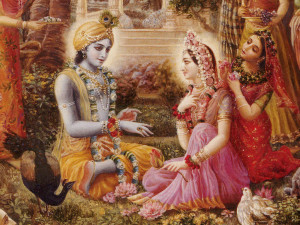
Sri Sri Radha and Krishna in Vrindavana
So, Srila Svami Maharaja miraculously made these two kinds of desert like hearts, very fertile. He made them fertile by his harikatha, by his exposition on the pastimes of Krishna and by his own practice of bhakti. If you aren’t practicing bhakti and have not established yourself in the line of devotion, then you may chant harinama ten lakh times, but no change will manifest. Srila Bhaktivinoda Thakura and all our disciplic Acharyas have practiced devotion to Krishna themselves, and then they have preached what they have practiced. Sri Caitanya Mahaprabhu has ordered His devotees to practice and then preach.
yare dekha, tare kaha ‘krsna’-upadesa
amara ajnaya guru hana tara’ ei desa
–Sri Caitanya-caritamrta Madhya 7.128

Lord Gaurasundara Lord Caitanya Mahaprabhu
[Instruct everyone to follow the orders of Lord Sri Krsna as they are given in the Bhagavad-gita and Srimad-Bhagavatam. In this way become a spiritual master and try to liberate everyone in this land.”]
First, practice devotion in your lives. Your behaviour must reflect your devotion. And then, if you have realized something; preach to others. They will also become devotees. Being trained by its master, a parrot repeats, “Hare Krishna Hare Krishna.” But, if a cat comes and attacks the parrot, the parrot forgets to repeat Hare Krishna, and instead, shouts for its master. So, we should not be like a parrot that only repeats what it has been told.
We just sang the bhajan, “Sri Guru carana Padma, kevala bhakti sadma,” that has the excerpt, “Divya jnana hrde prakasito.” What is the meaning of this excerpt? We should realize the import of this bhajan. If you are chanting like a parrot, you will not have prema bhakti. The chanting will create some good impressions, impressions that karmis (materialists) and yogis seek, acquiring which they will be very happy in this world. You can also get salvation by this nonchalant chanting, but you will not get Vraja prema for which Caitanya Mahaprabhu, our Guruvarga, and Svamiji came to give to the conditioned souls of this world. You will not be able to attain this prema.
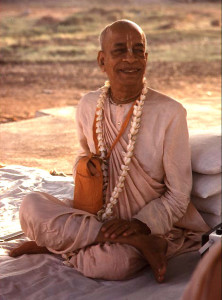
Srila Bhaktivedanta Swami Prabhupada
“Divya jnana hrde prakasito,” what is divya jnana? You will have to try to know what divya jnana is. “Caksu dana dilo jei, janme janme prabhu sei, divya jnana hrde prakasito,” chanting, chanting, and also engaging in kirtana to the accompaniment of the playing of the harmonium, mrdingas, karatalas, and dancing; but not knowing anything of this divya jnana, transcendental knowledge, then what will be the effect? You should try to know the deep underlying moods of this kirtana. “Caksu dana dilo jei,” what is caksu dana?
It is the vision by which you will realize that you are not this physical, mortal body. You may manage to have all worldly requirements and facilities like how Hiranyakasipu did, he had many boons that made him nearly invincible or like Ravana, who ruled over the city of Lanka, which was made entirely of gold. He didn’t have only son. He had one lakh sons and one hundred, twenty five thousand grandsons. Each son had a golden palace. Their kingdoms were far more advanced that any scientist could ever imagine. Scientists have made many countries like—England, France, Germany, and America very advanced, but yet, the citizens of these countries are not satisfied. Ravana could not be satisfied, he was killed with all his brothers, sons, and grandsons. The golden city of Lanka was burnt to ashes. Material facilities and advancements cannot help us. “Divya jnana hrde prakasito,” we are all the servants of Krishna, His part and parcels. We are not of this material world. We have come like refugees here for some days. We should realize this by divya caksu, transcendental eyes. We should come to the conclusion that we cannot live in this world as refugees for more than hundred years. Out of those allotted hundred years, half of the time, is spent in sleeping. And those who are not Jitendriyah, who haven’t conquered their senses, they will sleep even more. They will sleep for more than twelve hours a day.
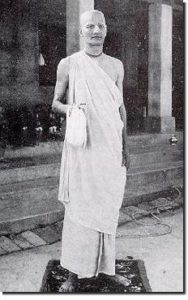
Srila Bhakti Prajnana Kesava Gosvami Maharaja
So, one half of a person’s life is spent entirely in sleeping. And then, out of the remaining fifty years, twenty years or more will be spent during one’s childhood upbringing, and education, where the student wants to become a doctor, engineer, business man or a leader. By spending time in getting educated this way, they will be qualified to earn more and more, and thus, they will aim to fulfil their worldly requirements. So, a lot of time is spent in earning money. And in the age between eighty to hundred, you will become so old that you will not be able to move without the help of a stick. Your hair will become dry and your eyes will lose their power of sight. Your teeth will fall out. When the age of forty comes, your hair will start turning white, but being undeterred, you will have them removed. But after single strand of hair is removed, on the next day, you will see that many strands of hair have turned white. After some time, you will see that half the hair on your head has turned white. Then you will think, “What to do?” At that time, you will not be able to do anything, you cannot do anything. You will be old, and after that, you will die.
Therefore, out of hundred years; fifty years is spent in sleeping; twenty years is spent in an upbringing and on one’s education. Old age will conquer twenty years. This way, ninety years is lost. For the remaining ten years, you will plan and think, “I have to marry. I have to raise children and make them qualified. I have to earn enough money to buy a television, car, and many other things.” Sitting within your living room, by the medium of the television, you will see all that is happening around the world. Sitting and lying down in your home, you especially want to see football and cricket.
[Laughter]
So, the remaining ten years will also pass this way. When will you realize, “I should serve Krishna.” But, even if you desire to serve, you will have no time. You should try to serve Krishna from your boyhood. And to aid you in your service to Krishna, you must have the association of bona fide Guru and Vaisnavas. If you don’t follow the instructions of Sri Guru and Vaisnavas, you will not be able to proceed an inch in the realm of bhakti. “Krishna bhakti janma mula hoya sadhu sanga,” sadhu sanga is the mother of Krishna bhakti. If there is no sadhu sanga, there is no bhakti. But, sadhu sanga is rarely found in this world. Sadhu sanga is very rare indeed. There are many people who don the guise of a sadhu, they will wear red cloth and claim that they are of the renounced order. But they have no divya caksu, transcendental eyes. So, many problems come. Hence, it is stated here that a person should be in sadhu sanga from the beginning of his life and accept the shelter of a real guru. But how to accept the shelter of a real guru? You cannot manage to find a bona fide guru by yourself. If you have past samskaras, where you have rendered any service to Krishna, Krishna bhakti, the devotees, Vrindavana, Yamuna, and Ganga, then as a fruit of this service, Krishna will very easily manage a bona fide guru and sadhu sanga for you. Otherwise, it is very hard to find a bona fide guru and the association of devotees.
So, if you have performed these activities that are conducive for devotion for lakhs and lakhs of births, then sadhu sanga will be obtained. But, if you don’t have the necessary samskaras, impressions from previous lives, then on coming across a sadhu, you may associate him with a couple or more days and then leave his association. By leaving his association, your heart will be dry. I think when Svamiji returned to serve his Divine Couple, many of his disciples’ hearts became dry. The devotees having these dry hearts left ISKCON, re-married, and returned to their previous materialistic ways. Many persons in the renounced order of life re-married or without being married, they left their renounced order and went to various places. So, you will always need the association of a high class of Vaisnava. This Vaisnava should be more advanced and qualified than you. By his association, bhakti will come. But, in Caitanya Caritamrita, Sri Raya Ramananda Prabhu stated:
krsna-bhakti-rasa-bhavita matih
kriyatam yadi kuto ‘pi labhyate
tatra laulyam api mulyam ekalam
janma-koti-sukrtair na labhyate
—Sri Caitanya-caritamrita Madhya 8.70
[‘Pure devotional service in Krsna consciousness cannot be had even by pious activity in hundreds and thousands of lives. It can be attained only by paying one price-that is, intense greed to obtain it. If it is available somewhere, one must purchase it without delay.’]
You can have the association of a devotee by the sukriti accrued from over a thousand lifetimes. But, to have the association of a bona fide and Rasik Vaisnava who is in the line of Rupa Gosvami, is extremely rare. All our Acharyas were bona fide and Rasik Vaisnavas. By the causeless mercy of Krishna, Caitanya Mahaprabhu, or the by the mercy of any rasik, tattva-vit Vaisnava, whose transcendental eye has opened and hence, is conversant with all the tattvas; by his association, you can have Krishna bhakti. Raya Ramananda Prabhu clearly explained to Caitanya Mahaprabhu in their dialogue, of how important it is to seek the association of a rasik, tattva-vit Vaisnava. By this Rasik Vaisnava’s association, greed to serve Krishna in Vraja will arise. The devotee will want to serve Krishna as a friend, or as His parents-Nanda and Yasoda, or like the gopis. This is called Ragunuga bhakti.
Devotion from the beginning is characterized by two kinds of shraddha. Do you know what shraddha is?
Devotee: Faith.
Srila Gurudeva: The word, ‘faith,’ doesn’t cover all the meanings of shraddha. But there is no other word from the English language that can be used to translate this word. Do you know what the root or seed of bhakti is? Some say, “Shraddha is the seed of bhakti.” But no, shraddha is the external and internal symptoms of bhakti. The seed of bhakti is the desire to serve Krishna.
“I should serve Krishna, if my life is going to end, no harm; but I will never abandon this desire,” this conviction is called, “Krishna seva vasana,” in Sanskrit. Guru sows the seed of devotion to Krishna in the heart of the surrendered disciple. Those who don’t want anything worldly; who don’t want to go to the heavenly realms or to the Vaikunta planets; who don’t want any kind of salvation—then Gurudeva blesses this kind of disciple by firstly bestowing divya jnana. Guru tells the disciple, “You are not this body. You are a part and parcel of Krishna; a servant of Krishna. Krishna is the Supreme Personality of Godhead. Srimati Radhika is His hladini sakthi, His pleasure potency. You should serve Them.” Guru gives the mood of service to his disciple by the medium of his harikatha—his exposition on the pastimes of Krishna, Caitanya Mahaprabhu, and Nityananda Prabhu. Thus, the seed of devotion is sown in the pure heart of a disciple. The heart of the disciple may also be impure, but the disciple will have some faith in his Gurudeva, Vaisnavas, and in scriptures like the Srimad Bhagavatham, and the Bhagavad Gita. These are the external symptoms of shraddha.
The internal symptoms of the bhakti of a devotee is characterized by the mentality, “If any difficulties or troubles affect me, I will remain undisturbed and I will never leave Krishna bhakti.”
khanda khanda hai’ deha yadi jaya prana
tabu ami vadane na chadi harinama
–Sri Caitanya-bhagavata Adi 11.91
[Even if you cut my body into pieces, I will never give up chanting the holy name.]
Srila Haridasa Thakura had this unflinching determination in chanting harinama. He told his tormentors, “Even if my body is cut into lakhs of pieces, I will be the first person to take a stand and never leave bhakti.”
So, “Shraddha sabde visvas kohe sudrda niscaya, Krishna bhakti koile sarva karma krta hoya,” if a devotee listens to his Gurudeva saying, “You must serve Krishna. You must receive and exchange gifts with devotees.” After listening to his Gurudeva speak, the disciple will have so much faith in the words of his Gurudeva, good devotees, and in our bhakti books like Srimad Bhagavatham, Sri Bhagavad Gita, and Sri Caitanya Caritamrita. The three—Sri Guru, Vaisnavas, and scriptures, are one. If there is something that you do not understand or follow, you must carefully reconcile. Sastra may state one meaning, while Sri Guru and Vaisnavas may state another meaning. To reconcile this conflicting situation, you will have to place your faith wholeheartedly in the words of Sri Guru and Vaisnavas. If a guru speaks something else, while Sastras and Vaisnava are of one opinion; then we will have to reconcile. If a guru is unable to reconcile this apparent misunderstanding, then instead of following him, you should follow the words of Sastra and Vaisnavas. You must have the preliminary understanding that a guru will never speak something that is contradictory to the words of sastra and Vaisnavas. But you may not understand the intentions behind guru’s words, so you will have to place your faith in the Bhagavat, Bhagavad Gita, and in all the sastras written by Rupa Gosvami and our Acharyas.
A person may be very sinful, he may be a drunkard, and he may be very fallen; but if he has the desire, “I must serve Krishna, I have so much faith in Guru, Vaisnavas, and sastra,” then this person is shraddalu, faithful. Guru doesn’t initiate this person, rather, he sows the seed of devotion in this person and speaks harikatha again. By this harikatha, the seed of devotion is nourished. Harikatha is like water that propels the growth of the seed of devotion. We should nourish the seed of devotion and it will gradually sprout. But this seed of devotion will not sprout in a day or two, you will have to wait. You may sow a seed, but being impatient, if you remove the seed from the earth within a day or two to see if it has sprouted, then what will be the result? The seed will wither and dry itself out. We should have the faith that in time, the seed will sprout and grow into a very good tree that will bear many fruits and flowers. These fruits will mature and ripen, and on being eaten, they will produce a beautiful, sweet taste. But the seed will grow into a tree and produce succulent fruits at an appropriate time.
We know that Ajamila was a bad person. At first, he was a good person. He was the son of a Brahmin, and of good character. He diligently served his parents, his wife was very chaste and good. His children were educated. But despite having a good family, he fell in the trap of a prostitute and he could not change his mind. He started living with the prostitute, and bore many sons from her. He named his last son as Narayana. Srila Vishvanatha Cakravarthi Thakura tells us that the first time Ajamila called his son, “Narayana,” he got out of maya’s influence. But, he was unaware of this fact. He would often call his son and say, “Narayana, Narayana, come and sit on my lap.” By repeatedly calling for his son, Ajamila practiced chanting harinama. But, he was oblivious of this unintended chanting. When death came for Ajamila represented by Yamadutas, the messengers of Yama Maharaja, who tried to separate him from his body; then he naturally called out for his youngest son and cried out, “Narayana! Narayana!” At that moment, three effulgent personalities descended in front of him. Who were they? When you commit any sin or pious activities by your thoughts, words, or actions—tan, man, vachana…
[Break of audio]
Sita-devi was applying sindhur (vermilion) at the parting of the hair, according to Vedic custom. Do you know what sindhur is? Married Indian ladies apply this reddish vermilion at the parting of the hair. So, Sita-devi was applying this sindhur.
Seeing this sight, Hanuman asked her, “Mother, what are you doing? What is this that you apply?”
Sita-devi replied, “By applying this sindhur, Rama will never die. He will always be in good health and He will be glad and satisfied. I will be sauhagini—a chaste lady who controls her husband.” Hanuman was satisfied by this answer. As soon as Sita-devi went out of the room, Hanuman emptied the entire pot of sindhur and covered his entire body with this reddish powder. Entirely covered by this powder, Hanuman entered the royal assembly of Rama. On seeing Hanuman, all the members of the assembly started laughing and told each other, “What has Hanumana done?” Mother Janaki was also laughing.
One of the members asked Hanuman, “What have you done? Have you manifested your monkey nature?”
Hanuman replied, “I saw Mother Janaki applying this powder on the parting of her hair, so that Rama will have a long, happy life. So, mother applied this powder only on the parting of her hair, but I decided to cover my whole body with it, because Rama will then always be happy and He will never die.”
So, Hanuman’s service to Rama was incomparable, but he cannot go to Vrindavana. He cannot go. Why? If he sees Mother Yasoda disciplining her son, Krishna, Hanuman will think, “My Lord is being disciplined?” Thinking so, he will be upset. With his club, he might do something wrong. If he will see that in the groves of Vrindavana, Srimati Radhika and the gopis order Krishna and tell Him, “Come on! Come on! The colors painted on our feet has been washed away, so You should paint our feet.” Hanuman will also see Krishna praying to the gopis. Hanuman will think, “What is my Prabhu doing?” And he will again be upset. So, Hanuman never goes to Vrindavana because he is of dasya-rasa (the mood of being the servitor of the Lord). Dasya-rasa is not to be considered lowly, it is achieved only after liberation. Dasya-rasa is of two kinds. In the Vaikunta realm, there are four kinds of liberation—sarupya (having bodily features that resemble the Lord’s), samipya (equal association with the Lord), sarsti (equal possession of opulence like that of the Lord), and salokya (equal facility to live on the same planet of the Lord). Sayujya-mukti, to become one with the bodily effulgence of Krishna must be discarded. This kind of impersonalistic liberation is a great curse. But the other four kinds of liberation may be accepted by the lower class of devotees. Being four handed like Lord Vishnu or Narayana, and embellished with the conch, discus, club, and mace, they are situated in the lower half of Vaikunta. Residing there, they are liberated and experience some happiness.
But, those devotees who proceed to the higher regions of Vaikunta, can serve the Lord there like His associates—Jaya and Vijaya. This form of devotion is called prema-seva-uttara. But, the servants of Krishna like Chitraka and Patraka, whose mood of servitorship is mixed with the mood of friendliness; they are so much more superior and liberated.
Caitanya Mahaprabhu is asking Raya Ramananda Prabhu questions, and He is gradually giving the devotees the culmination of the highest forms of love and affection to the Lord. After glorifying dasya-rasa (the mood of servitorship), Raya Ramananda Prabhu will speak on sakhya-rasa (the mood of friendship), and he will gradually speak on vatsalya-rasa (the mood of parenthood), and madhurya-rasa (the mood of considering Krishna as the beloved).
So, I want to stop here because I have been advised by the doctors to not speak for long. Now, harinama should be chanted and sung. You should try to have a very regular and good association of bona fide devotees. The seed of devotion has been planted in your hearts, but if you don’t water this seed of devotion with the water of harikatha; it may dry and be destroyed. You should carefully and diligently tend to this seed of devotion. You should always be in good association and you must also sincerely study scriptures like Srimad Bhagavatham, Srimad Bhagavad Gita, and all other books of Srila Rupa Gosvami, Srila Svamiji, and our Guruvarga. Thus, we should gradually advance in our Krishna consciousness.
Gaura Premanande! Hari Haribol!
http://www.harekrishnasociety.com

 Posted in
Posted in 





